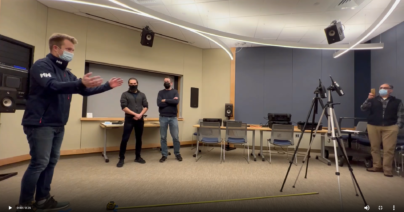Imagine that you have been working on a complicated and difficult project for a demanding client. It has required various inputs, third party materials and acoustic data, mathematical modeling, some electronics and so on. You have predicted its noise level at a meter will be within a dB or two of 40 dB. Finally the moment of truth arrives: the device is assembled and you turn it on and look at the SLM and see 41 dB. You breathe a well-deserved sigh of relief and if you are like me, you may turn to your colleague and mutter “well, well, ain’t science wonderful.” While this may seem to be just a joke, there is much more to it. It is a recognition that you got to this point because of the absolute reliability of however many scientifically correct steps that went into your design process. At no point did F not equal ma. It is also very reassuring, as it is an often subconscious expression of confidence that you can rely on science again for your next project.
The narrative is an example of the deep and often overlooked chain of physical reality that can link disparate events through an often long series of physical connections that may not seem explicitly connected to the phenomenon involved. In our example some of the links are the precise operation of calibrated speakers and microphones in a remote testing lab, the mathematical models, components testing, the hardware and software in the SLM, etc. This is a simple example of the remarkable consistency and reliability of science and mathematics that we rely on, often subconsciously.
This brings me to the topic of this blog, one of my favorite examples of the chain of physical reality associated with seemingly unrelated events. On February 24, 1987, in a vessel filled with 2000 tons of water deep within a zinc mine in Kariokande Japan, there were eleven small flashes of light over a 13 second period. About two hours later on the other side of the world in Chile, a bright explosion of a star named supernova 1987A was observed in the Large Magellenic Cloud, a “local” galaxy a mere 168,000 light years away. The unprecedented observation a supernova almost from its first hours created a treasure trove of new information. But of equal or possibly greater excitement, it was immediately recognized that the flashes of light at Kariokande announced the arrival of subatomic particles called neutrinos from the supernova even before it was visible, precisely as theory would have predicted. What is so remarkable about this is the long and complex chain of physical reality connecting these apparently disparate events. In what follows I will try to summarize this remarkable chain.
A supernova is an astounding explosion of a star at the end of its normal life. Stars are born as a ball of gas initially contracting under its own gravitation, and the temperature in its interior regions gets so hot (on the order of 109 oC) that hydrogen nuclei move so fast that they can overcome their natural columbic repulsion and collide and fuse to form helium. The resulting helium nucleus weighs less than the two hydrogens and the missing mass is converted into significant energy by E =mc2. This energy works its way outward and exerts outward forces that just balance the inward pull of gravity, so the star stops collapsing and reaches a comfortable equilibrium. The fusion energy flows out to the star’s edge and eventually into space, fortunately for us. This is the same process in hydrogen bombs and is the basis of the promise of fusion energy. But eventually the hydrogen runs out and fusion and the outward forces weaken and inward gravitational forces take over until the interior temperature rises even higher to start fusing helium into even heavier elements to release energy and a new equilibrium is found until the helium runs out and the process repeats with the burning of carbon. However this cannot go on forever and, depending on the individual conditions, gravity eventually takes over when there is no longer any thermonuclear option and the star collapses on itself, igniting a supernova. The core collapses to form a neutron star or a black hole and in the process almost all the gravitational energy in the star is converted to an enormous outward flux of elementary particles called neutrinos. About 1058 neutrinos carried about 1046 Joules away from 1987A. This creates a gigantic bounce wherein a substantial fraction of the star’s material outside the collapsing core is blasted away into space, and a visible supernova is on its way. The light from one can temporarily outshine that of all the other stars in its galaxy.
Now, about neutrinos: These are essentially massless ghostly particles that move at almost the speed of light but almost never interact with anything. There are probably trillions of these particles, mostly from the sun, passing through your body every second. They are hard to detect! Nevertheless, three neutrino detectors saw a total of 25 neutrinos from the supernova that day (out of the 1058 that started out in the Large Magellenic cloud 168,000 years ago.) How does this work? When a neutrino enters the tank, the chances of it interacting with anything are extremely small but with, for example 2000 tons of water at Kamiokande II, a small number of interactions can occur. The neutrino collides with a proton in a hydrogen atom and the result is a neutron and a positron (a positively charged electron antiparticle). The positron comes away with the vast majority of the energy involved and moves through the water almost at the speed of light, and most importantly somewhat faster than the speed of light in the water. In very good analogy to a sonic boom formed when an object travels faster than the speed of sound in air, this produces a shock wave and a flash of light known as Cherenkov radiation. The eleven flashes of light seen in Kamiokande II two or three hours before the supernova light was first seen were supernova neutrino-induced Cherenkov radiation. That the neutrinos got here first was also anticipated as they were able to travel straight out through collapsing star while the light took a few hours longer to escape due to its much stronger interactions with the stellar materials.
So we see that observing a supernova with a telescope in Chile and the detection of 11 flashes of light in an underground tank of water two hours earlier are seemingly different kinds of events. However they are deeply connected by an incredible complex chain according to the laws of physics extending over 168,000 years and a vast distance. This is one of my favorite examples of the chain of physical reality. Others, including the discovery of the primordial black body radiation of the universe, will be the subject of subsequent blogs.
 Articles
Articles



